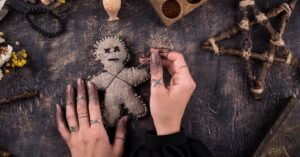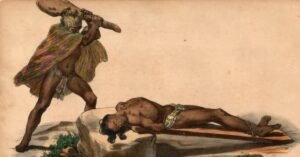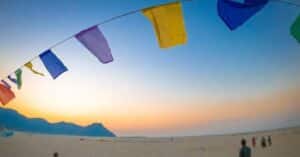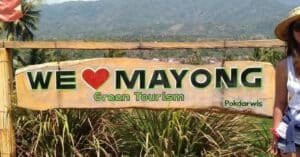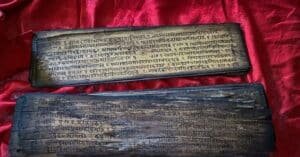Situated in the Morigaon district of Assam, the erstwhile kingdom of Mayang, is perhaps best known as the ‘land of black magic and witchcraft’. The village Mayong is situated at the border of Kamrup and Morigaon district of Assam. The common people of Assam believed and some still believe that the people from Mayong are masters of the art of black magic. In this blog, we will discuss the history and stories of black magic in Mayong.
Read this blog to know the history of Mayong Kingdom
Before we talk about the practice of black magic in Mayong, let’s read some short one-liners about the people of Mayong as per the folklore of Assam.
Stories of Black Magic in Mayong (as per the local folklore)
If a man goes to the houses of Mayong as a guest and sits on a chair, his seat would stick to him and does not drop off until counter-incantations are recited.
The black magic practitioners of Mayong can make a tree stand, although it is cut through, and can make it fall only, when the enemy whom the practitioner wishes to injure comes up to it.
If you eat a cooked pigeon spelled by black magic practitioners of Mayong, it becomes alive inside the stomach, and flaps its wings incessantly kills the man.
It is also believed that the people of Mayong keep bira and daini and other spirits in their houses. These are employed for harming others. They regularly offer puja to these spirits in a secluded corner of their houses.
There are thousands of more stories like these in the folklore of Assam, that describes about Mayong and its people. Not many years ago, people feared to visit this land because of these stories.
Are Black Magic in Mayong real? Are those stories true? We will soon find out. Let’s first analyse the history of the area.
History of Black Magic in Ancient Assam
Assam is known for its magic since ancient times. Kamrupa (ancient name of Assam) was known for Shaktism and Shaivism. Saktism is the cult of worshipping a female goddess as the chief deity. The deities include Chamunda, Devi, Durga, Kamakhya, Kali etc. Shaivism is cult of worshipping the Hindu God Shiva. One of the best known shrines of Saktism in India is the Kamakhya temple which is known for tantric sacrifices, mysticism and sorcery.
In Assam, the synthesis of these two cults Shaktism and Shaivism produced a unique blend of religious practice that is Tantricism. In Tantricism, various occult spells and rituals were practised publicly. These rituals included human sacrifice, magic spells, meditation to gain occult power, worshipping of occult power etc. Main tenets of Tantricism are mentioned in two books namely Yogini Tantra and Kalika Purana.
In addition, Kamrupa was once a centre of Vajrayana sect of Buddhism which engaged in tantric practices. As a result, Tantricism as practised in Buddhism was also mixed with it. Overall, from 7th century to 12 century CE, Kamrupa (Assam) was a land of mystery and magic powers.
Did you know that the Sakta worshippers used human skulls as drinking vassals?
Moreover, as a frontier region, Assam appears to be a veritable asylum for all kinds of uncanny beliefs and superstitions. Since early times, the state of Assam happened to be a meeting ground of the Austric, Dravidian, Aryan and Sino-Tibetan speakers, and thus the aboriginal beliefs, cults and myths of these diverse communities mingled together and formed the foundation of the Tantricism.
History of Black Magic in Mayong
Even though Tantricism and black magic was prevalent at various places of ancient Kamrup. Two places namely the Nilachal Hill and the Mayong village were particularly famous for it. In Nilachal Hill, the practise was prevalent due to the existence of Kamakhya temple. Mayong, on the other hand offered favourable conditions to the followers of Tantricism. Mayong was a veritable natural fort as it was bounded by the river Brahmaputra in the north and various rivers and hills in south and east. As a result, Yogis and other practitioners decided to perform their rituals and black magic in Mayong.
Mythological Story Behind the Practice of Black Magic in Mayong
According to a popular myth, Mayong with a lofty hill on the bank of the Brahmaputra river was the favourite place of goddess Kamakhya. It is believed that there was a Sakti shrine located in the Mayong hill, above the present water body (barghat) at Burhamayong village. It is said that Devi Kamakhya visits the place every year on the sixth day of the month of Bahag (April-May) along with other gods and goddesses. There is a belief that the name Mayong is derived from maya or illusion where the Devi Kamakhya and other gods experienced maya at this place.
It is said that Narakasura, the mythological king of Assam, prohibited the Tantric practices in the temple of Kamakhya after he was deceived by the goddess Kamakhya in his attempt to marry her. After that it is believed that Tantric practices were carried out secretly for fear of Narakasura. It is during this period that Mayong became a centre of the secret practice of Tantra.
Read this blog to know more about stories of Kamakhya Temple
Evidence to Support the Practice of Black Magic in Mayong
There are archaeological relics, artifacts, and manuscripts that are believed to be associated with black magic practices in Mayong. Swords and sharp weapons that resemble tools used for human sacrifice (narabali) were discovered near many shrines of Mayong to support the fact that human sacrifice and necromancing were not uncommon in Mayong. The Mayong Central Museum and Emporium has preserved artefacts such as swords and pots that are believed to have been used in mysterious black magic rituals. Inside the museum, there are Mantraputhis or the book of magic spells. The manuscripts called ‘Mantraputhis’ provide details on black magic practices. There are innumerable mantras/spells such as Luki mantra (for disappearing from human sight), Murarbikhar mantra (for curing headache), Bhut bakhikaran mantra (for control over ghost) etc. These are all mentioned in those books. Many mantras were handed down by word of mouth; though some have also been preserved in written form.
The scripts used in the mantraputhis of Mayang were Kaithali, Bamunia and modern Assamese. Presently, around fifty mantraputhis are preserved in the Mayang Central Museum and Emporium and rest of them are scattered in different villages of the area under individual ownership.
Who were the practitioners of Black Magic in Mayong?
The indigenous healers in the region are referred to as bez and kabiraz. Even in contemporary times, these traditional practitioners, namely bez and kabiraz, continue to play a vital role in the community. Moreover, it can be inferred that women in Mayang have been actively engaged in this domain, given that a significant number of them are knowledgeable about various mantras. Additionally, the practice of tantricism is open to individuals of all castes and creeds, with adherents believing that it holds the potential to guide them toward salvation.
Is Black Magic is still practised in Mayong?
Black magic similar to the folklore of Mayong is non-existent now a days. No one knows the actual account of such black magic and what happened to these spells. But various forms of healing practises are still prevalent in Mayong. It includes fortune telling, palm reading, treating minor ailment etc. There are as many 150 bez (tantric practitioners) in Mayong. Spells or mantras were passed on to them heredically by their forefathers. People still seek the opinion of these practitioners in treating misfortune, snake bites, possessed souls, mental diseases etc.
Places of Black Magic in Mayong
There are many Sakta shrines and temples in Mayong and they are popularly known as thans (shrine) e.g. Kechaikhati than, Bhagavati than, Manasha than, Aai etc. Almost every village has a shrine (than) of the Mother Goddess, in one of her manifestations. All these places were important centers of black magic in Mayong. Though practice of black magic has been abolished, rituals associated with black magic is still performed in those thans.
Places of Mayong That Portrays its history of Black Magic
Mayong Hill
The village Burha Mayong is located just below a hill, which is called Mayong hill. This is the biggest hill in the whole of undivided Nagaon district. The Mayong Hill is a centre for adoration of the Mother Goddess Kamakhya. The shrine located on the Mayong hill is regarded to be that of Kamakhya. To differentiate it from the Kamakhya temple atop Nilachal hill in Guwahati it is called the Mayong Kamakhya
Kechaikhati Than/Thaan
Kechaikhati Than or Kesaikhaiti than is known for its ancient practice of human sacrifice. It is believed that the goddess of shrine used to eat human/animal flesh raw. That is why it is named as Kesaikhati (in Assamese, kesa means raw). The above shrine is located near Burha Mayong and you will have to walk through small village to visit this place. Though black magic is not practised in this place now a days, the place is very sacred to the people of Mayong.
In Burha Mayong village, there are other historical places such as Shiva-parvati statue, Ganesh Statue and one shrine name Yonipeeth. You can explore these places to get an idea of the mystical history of Mayong.
Mayong Museum of Black Magic
It is located in Raja Mayong village. The collection boasts a fascinating array of items, including enigmatic relics like snake skulls, tortoise shells, and intricately preserved scriptures. Among the captivating exhibits are vivid depictions of Bez, practitioners of sorcery in Mayong. The museum not only serves as a visual feast for enthusiasts of the arcane but also stands as a testament to the cultural and historical significance of Mayong.






